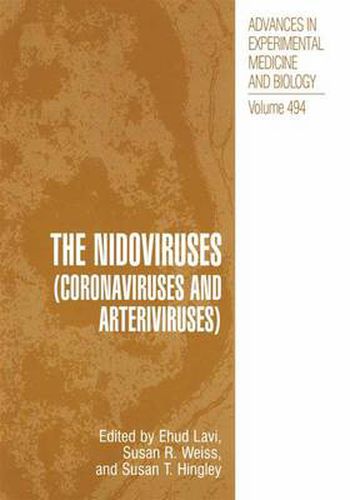Readings Newsletter
Become a Readings Member to make your shopping experience even easier.
Sign in or sign up for free!
You’re not far away from qualifying for FREE standard shipping within Australia
You’ve qualified for FREE standard shipping within Australia
The cart is loading…






This title is printed to order. This book may have been self-published. If so, we cannot guarantee the quality of the content. In the main most books will have gone through the editing process however some may not. We therefore suggest that you be aware of this before ordering this book. If in doubt check either the author or publisher’s details as we are unable to accept any returns unless they are faulty. Please contact us if you have any questions.
In 1996 the International Committee for Taxonomy of Viruses (ICTV) recognized the name Nidovirales, as the formal name for Coronaviridae and A rteriviridae. In recognition of this change, and in response to the wishes of our colleagues we named this meeting for the first time The International Symposium of Nidoviruses . The meeting in the wooded environment of Lake Harmony, Pennsylvania, provided a stimulating opportunity for assessing the progress made in the field since the last meeting in Segovia Spain in 1997. Over 150 scientists from academia and industry attended the meeting. The meeting hosted senior members of the Nidovirus community, some of whom have been studying the subject for over 20 years, as well as younger scientists, the next generation of Nidoviro10gists. The traditional informal format, the shared meals, the social activities and the relatively inexpensive venue made the meeting a popular adventure. In her opening remarks Susan Weiss showed pictures from previous meetings, reminding us how young we used to look. Neal Nathanson was our keynote speaker at the opening night, giving an overview on how viral pathogenesis studies helped in shaping the evolution of viral research and vaccine development. The scientific program of the meeting was divided into 9 sessions including lO keynote presentations. The meeting opened with a session on epidemiology, evolution and genome structure. Sasha Gorbalenya shared with us insights gained from comparative sequence analysis, emphasizing the unifying traits among nidovriuses, but also pointed out the remaining black holes .
$9.00 standard shipping within Australia
FREE standard shipping within Australia for orders over $100.00
Express & International shipping calculated at checkout
This title is printed to order. This book may have been self-published. If so, we cannot guarantee the quality of the content. In the main most books will have gone through the editing process however some may not. We therefore suggest that you be aware of this before ordering this book. If in doubt check either the author or publisher’s details as we are unable to accept any returns unless they are faulty. Please contact us if you have any questions.
In 1996 the International Committee for Taxonomy of Viruses (ICTV) recognized the name Nidovirales, as the formal name for Coronaviridae and A rteriviridae. In recognition of this change, and in response to the wishes of our colleagues we named this meeting for the first time The International Symposium of Nidoviruses . The meeting in the wooded environment of Lake Harmony, Pennsylvania, provided a stimulating opportunity for assessing the progress made in the field since the last meeting in Segovia Spain in 1997. Over 150 scientists from academia and industry attended the meeting. The meeting hosted senior members of the Nidovirus community, some of whom have been studying the subject for over 20 years, as well as younger scientists, the next generation of Nidoviro10gists. The traditional informal format, the shared meals, the social activities and the relatively inexpensive venue made the meeting a popular adventure. In her opening remarks Susan Weiss showed pictures from previous meetings, reminding us how young we used to look. Neal Nathanson was our keynote speaker at the opening night, giving an overview on how viral pathogenesis studies helped in shaping the evolution of viral research and vaccine development. The scientific program of the meeting was divided into 9 sessions including lO keynote presentations. The meeting opened with a session on epidemiology, evolution and genome structure. Sasha Gorbalenya shared with us insights gained from comparative sequence analysis, emphasizing the unifying traits among nidovriuses, but also pointed out the remaining black holes .